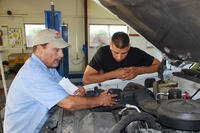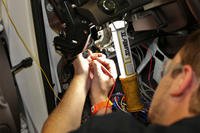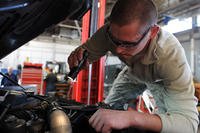by Aaron Bersee
Jump Links
When discussing speed in relation to a car or truck, the conversation usually refers to miles per hour a vehicle can travel, as seen on a speedometer. However, aside from the vehicle, the engine too has a speed of its own. This engine speed is called revolutions per minute, or rpm. The definition of RPM is the measurement of how many times an engine's crankshaft makes one complete rotation within one minute. Engines like the one found in the Lamboghini Temerario can achieve up to an astounding 10,000 RPM while engines like the 6.7 Cummins diesel will only spin to around 3,000 rpm. In this article we will explore engine rpm and its role in horsepower and torque production.
Not all engines operate in the same rpm band. The numbers below are presented as average rpm in normal driving conditions, unless expressed otherwise. Not all engines will experience catastrophic engine failure due to overrevving. That is a worst-case scenario. Always check your oil - always.
Engine Operation 101

BMW
The Internal Combustion Engine: Just An Air Pump
At its very core, an engine is just an air pump. Sure, there are a lot of other things going on, especially in a late-model engine, but if you peel back all the layers of this onion, every internal combustion engine does the same thing. Air gets pulled in, compressed and pushed back out all in the name of power production. This is all achieved by a set of pistons mounted on connecting rods, that are all attached to and rotate a common crankshaft. This is what makes up the rotating assembly that resides within the engine block. The movement of the pistons within the cylinder bore of that block, compressing a mixture of fuel and air that is then ignited, forces the piston down within the cylinder, rotating the crankshaft. This measured action happens hundreds to thousands of times within one minute, converting piston movement into rotational force. In a standard internal combustion engine, this gets broken down into four cycles, or strokes of the piston. Intake, compression, power and exhaust, in that order, spinning the crankshaft. This is the mechanical action of horsepower and torque production. Of course, that's a very simplified explanation. In reality, the engine is a well orchestrated series of combustion events and physics involving a plethora of precision-made engine parts working together, in time - to achieve a common goal without self-destructing.
Key engine components include:
- Engine block
- Crankshaft
- Connecting rods
- Pistons
- Camshaft
- Heads
- Valves (intake and exhaust)
- Push rods
- Valve springs
- Lifters
- Timing components
- Intake manifold
- Exhaust manifold
- Fuel delivery (carburetor or fuel injectors)
- Spark plugs
- Distributor or coil packs
The Heartbeat Of An Engine

Erik McLean/Unsplash
A Measurement Of Engine Speed
Engine rpm is often equated to the heartbeat of an engine. If the rpm is too low, the engine shuts down, while very high rpm can put the engine t risk of severe damage or, in the worst cases, total destruction. In a performance capacity, it's crucial to keep a watchful eye on the speed of the engine as over revving can be damaging to the engine. The tachometer is a gauge used to monitor the speed of an engine. Depending on the vehicle, a tachometer can get its rpm reading in different ways. One method includes a signal from a simple hall effect style pick - up and a wheel. These are usually mounted somewhere near the balancer, or the main crank pulley with the wheel mounted next to the balancer on the snout of the crank. Otherwise, engines use crank position sensors mounted in roughly the same location, and send a signal to the car's computer, ultimately sending the engine speed signal to the tachometer.
Read the full article on CarBuzz
This article originally appeared on CarBuzz and is republished here with permission.










